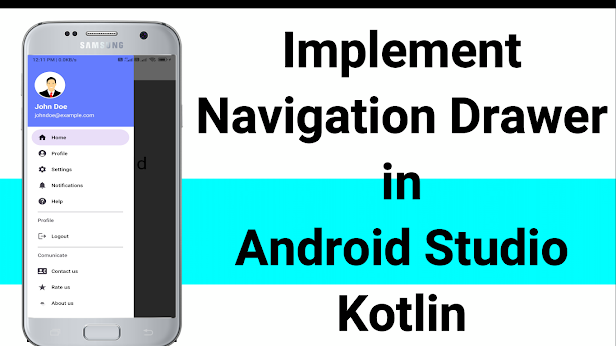Are you looking to create a smooth and intuitive user experience for your Android app? Implementing a navigation drawer could be the solution you need! In this tutorial, we'll walk you through the process of integrating a navigation drawer into your app using Kotlin in Android Studio.
Click here to Watch Video on Youtube
Step 1: Set up your project
To get started, open Android Studio and create a new project. Make sure you choose Kotlin as your programming language.
Step 2: Adding dependency to the project.
Add the CircleImageView library to an Android project, which provides a custom ImageView implementation that displays images in a circular shape.
build.gradle (Module: app)
dependencies {
implementation 'androidx.core:core-ktx:1.8.0'
implementation 'androidx.appcompat:appcompat:1.6.1'
implementation 'com.google.android.material:material:1.5.0'
implementation 'androidx.constraintlayout:constraintlayout:2.1.4'
testImplementation 'junit:junit:4.13.2'
androidTestImplementation 'androidx.test.ext:junit:1.1.5'
androidTestImplementation 'androidx.test.espresso:espresso-core:3.5.1'
implementation 'de.hdodenhof:circleimageview:3.1.0'
}
themes.xml
<resources xmlns:tools="http://schemas.android.com/tools">
<!-- Base application theme. -->
<style name="Base.Theme.MyApplication" parent="Theme.AppCompat.DayNight.NoActionBar">
<item name="android:windowTranslucentStatus">true</item>
<item name="android:windowLightStatusBar">true</item>
<item name="android:windowDrawsSystemBarBackgrounds">false</item>
<!-- Customize your light theme here. -->
<!-- <item name="colorPrimary">@color/my_light_primary</item> -->
</style>
<style name="Theme.MyApplication" parent="Base.Theme.MyApplication" />
</resources>
strings.xml
<resources>
<string name="app_name">My Application</string>
<string name="navigation_drawer_open">Open navigation drawer</string>
<string name="navigation_drawer_close">Close navigation drawer</string>
</resources>
colors.xml
<?xml version="1.0" encoding="utf-8"?>
<resources>
<color name="black">#FF000000</color>
<color name="white">#FFFFFFFF</color>
<color name="purple">#647CFD</color>
</resources>
Step 7: Create your menu items
Next, we need to create the menu items that will be displayed in the NavigationView. Open the res folder in your project, right-click on it, and select New -> Android Resource File. Choose "Menu" as the Resource type and name it "nav_menu". In the nav_menu.xml file, add the following code:
nav_menu.xml
<menu xmlns:android="http://schemas.android.com/apk/res/android"
xmlns:tools="http://schemas.android.com/tools"
tools:showIn="navigation_view">
<group android:checkableBehavior="single">
<item
android:id="@+id/nav_home"
android:title="Home"
android:icon="@drawable/baseline_home_24"
android:padding="10dp" />
<item
android:id="@+id/nav_profile"
android:title="Profile"
android:icon="@drawable/baseline_account_circle_24"
android:padding="10dp" />
<item
android:id="@+id/nav_settings"
android:title="Settings"
android:icon="@drawable/baseline_settings_24"
android:padding="10dp" />
<item
android:id="@+id/nav_notifications"
android:title="Notifications"
android:icon="@drawable/baseline_notifications_24"
android:padding="30dp" />
<item
android:id="@+id/nav_help"
android:title="Help"
android:icon="@drawable/baseline_help_24"
android:padding="10dp" />
</group>
<item android:title="Profile">
<menu>
<group android:checkableBehavior="single">
<item
android:id="@+id/nav_logout"
android:title="Logout"
android:icon="@drawable/baseline_logout_24"
android:padding="10dp" />
</group>
</menu>
</item>
<item android:title="Comunicate">
<menu>
<group android:checkableBehavior="single">
<item
android:id="@+id/nav_contactus"
android:title="Contact us"
android:icon="@drawable/baseline_chat_24"
android:padding="10dp" />
<item
android:id="@+id/nav_rate"
android:title="Rate us"
android:icon="@drawable/baseline_star_rate_24"
android:padding="10dp" />
<item
android:id="@+id/nav_about"
android:title="About us"
android:icon="@drawable/baseline_help_24"
android:padding="10dp" />
</group>
</menu>
</item>
</menu>
nav_header.xml
<LinearLayout
xmlns:android="http://schemas.android.com/apk/res/android"
xmlns:app="http://schemas.android.com/apk/res-auto"
android:layout_width="match_parent"
android:layout_height="wrap_content"
android:orientation="vertical"
android:paddingBottom="25dp"
android:paddingStart="20dp"
android:background="@color/purple">
<de.hdodenhof.circleimageview.CircleImageView
android:id="@+id/circle_image_view"
android:layout_width="80dp"
android:layout_height="80dp"
android:src="@drawable/ic_launcher_foreground"
app:civ_border_color="#FFFFFFFF"
app:civ_border_width="2dp"
android:layout_marginTop="60dp"
app:civ_circle_background_color="#4B60DD"/>
<TextView
android:layout_width="wrap_content"
android:layout_height="wrap_content"
android:text="John Doe"
android:textColor="@color/white"
android:textSize="20sp"
android:layout_marginTop="10dp"
android:textStyle="bold" />
<TextView
android:layout_width="wrap_content"
android:layout_height="wrap_content"
android:layout_marginTop="3dp"
android:textColor="@color/white"
android:textSize="15sp"
android:text="johndoe@example.com" />
</LinearLayout>
activity_main.xml
<?xml version="1.0" encoding="utf-8"?>
<androidx.drawerlayout.widget.DrawerLayout xmlns:android="http://schemas.android.com/apk/res/android"
xmlns:app="http://schemas.android.com/apk/res-auto"
xmlns:tools="http://schemas.android.com/tools"
android:layout_width="match_parent"
android:layout_height="match_parent"
android:id="@+id/drawer_layout"
android:fitsSystemWindows="false"
tools:context=".MainActivity">
<!-- android:fitsSystemWindows="false" -->
<TextView
android:layout_width="wrap_content"
android:layout_height="wrap_content"
android:text="Hello World!"
app:layout_constraintBottom_toBottomOf="parent"
app:layout_constraintEnd_toEndOf="parent"
app:layout_constraintStart_toStartOf="parent"
app:layout_constraintTop_toTopOf="parent" />
<androidx.coordinatorlayout.widget.CoordinatorLayout
android:layout_width="match_parent"
android:layout_height="match_parent">
<com.google.android.material.appbar.AppBarLayout
android:layout_width="match_parent"
android:gravity="bottom"
android:background="@color/white"
android:layout_height="85dp">
<androidx.appcompat.widget.Toolbar
android:id="@+id/toolbar"
android:layout_width="match_parent"
android:layout_height="?attr/actionBarSize"
android:layout_gravity="bottom"
android:background="@color/white"
app:layout_scrollFlags="scroll|enterAlways"
/>
</com.google.android.material.appbar.AppBarLayout>
<!-- Add your app's content here -->
<TextView
android:text="TechWorld"
android:textSize="50dp"
android:layout_marginTop="300dp"
android:textColor="@color/black"
android:textAlignment="center"
android:layout_width="match_parent"
android:layout_height="wrap_content">
</TextView>
</androidx.coordinatorlayout.widget.CoordinatorLayout>
<com.google.android.material.navigation.NavigationView
android:id="@+id/nav_view"
android:layout_width="wrap_content"
android:layout_height="match_parent"
android:layout_gravity="start"
app:headerLayout="@layout/nav_header"
android:fitsSystemWindows="true"
android:background="@color/white"
app:itemTextColor="@color/black"
app:menu="@menu/nav_menu" />
</androidx.drawerlayout.widget.DrawerLayout>
MainActivity.kt
import android.content.res.Configuration
import android.os.Bundle
import android.view.MenuItem
import android.widget.Toast
import androidx.appcompat.app.ActionBarDrawerToggle
import androidx.appcompat.app.AppCompatActivity
import androidx.core.view.GravityCompat
import androidx.drawerlayout.widget.DrawerLayout
import com.google.android.material.navigation.NavigationView
class MainActivity : AppCompatActivity() {
private lateinit var drawerLayout: DrawerLayout
private lateinit var navigationView: NavigationView
private lateinit var toggle: ActionBarDrawerToggle
override fun onCreate(savedInstanceState: Bundle?) {
super.onCreate(savedInstanceState)
setContentView(R.layout.activity_main)
drawerLayout = findViewById(R.id.drawer_layout)
setSupportActionBar(findViewById(R.id.toolbar))
supportActionBar?.setDisplayHomeAsUpEnabled(true)
navigationView = findViewById(R.id.nav_view)
toggle = ActionBarDrawerToggle(
this,
drawerLayout,
findViewById(R.id.toolbar),
R.string.navigation_drawer_open,
R.string.navigation_drawer_close
)
drawerLayout.addDrawerListener(toggle)
val navigationView = findViewById<NavigationView>(R.id.nav_view)
navigationView.setNavigationItemSelectedListener { menuItem ->
// Handle menu item clicks here
when (menuItem.itemId) {
R.id.nav_home -> {
// Handle home item click
Toast.makeText(applicationContext, "Home clicked", Toast.LENGTH_SHORT).show()
drawerLayout.closeDrawer(GravityCompat.START)
return@setNavigationItemSelectedListener true
true
}
R.id.nav_profile -> {
// Handle profile item click
Toast.makeText(applicationContext, "Profile clicked", Toast.LENGTH_SHORT).show()
drawerLayout.closeDrawer(GravityCompat.START)
true
}
R.id.nav_settings -> {
// Handle settings item click
Toast.makeText(applicationContext, "Settings clicked", Toast.LENGTH_SHORT).show()
drawerLayout.closeDrawer(GravityCompat.START)
drawerLayout.closeDrawers()
true
}
R.id.nav_notifications -> {
// Handle notifications item click
Toast.makeText(applicationContext, "Notifications clicked", Toast.LENGTH_SHORT).show()
drawerLayout.closeDrawer(GravityCompat.START)
true
}
R.id.nav_help -> {
// Handle help item click
Toast.makeText(applicationContext, "Help clicked", Toast.LENGTH_SHORT).show()
drawerLayout.closeDrawer(GravityCompat.START)
true
}
R.id.nav_logout -> {
// Handle logout item click
Toast.makeText(applicationContext, "Logout clicked", Toast.LENGTH_SHORT).show()
drawerLayout.closeDrawer(GravityCompat.START)
true
}
R.id.nav_contactus -> {
// Handle contact us item click
Toast.makeText(applicationContext, "Contact us clicked", Toast.LENGTH_SHORT).show()
drawerLayout.closeDrawer(GravityCompat.START)
true
}
R.id.nav_rate -> {
// Handle rate item click
Toast.makeText(applicationContext, "Rate clicked", Toast.LENGTH_SHORT).show()
drawerLayout.closeDrawer(GravityCompat.START)
true
}
R.id.nav_about -> {
// Handle about item click
Toast.makeText(applicationContext, "About clicked", Toast.LENGTH_SHORT).show()
drawerLayout.closeDrawer(GravityCompat.START)
true
}
else -> false
}
true
}
}
override fun onPostCreate(savedInstanceState: Bundle?) {
super.onPostCreate(savedInstanceState)
toggle.syncState()
}
override fun onConfigurationChanged(newConfig: Configuration) {
super.onConfigurationChanged(newConfig)
toggle.onConfigurationChanged(newConfig)
}
override fun onOptionsItemSelected(item: MenuItem): Boolean {
return when (item.itemId) {
android.R.id.home -> {
drawerLayout.openDrawer(GravityCompat.START)
true
}
else -> super.onOptionsItemSelected(item)
}
}
}
This code adds an ImageButton to the toolbar with the icon of three horizontal lines (often referred to as a "hamburger" icon) and a click listener that opens the navigation drawer.
Step 11: Test your app
That's it! You've successfully added a navigation drawer to your Android app using Kotlin in Android Studio. Now it's time to test your app to make sure everything is working as expected.
Final Result:
Conclusion
In this tutorial, we've covered the basics of implementing a navigation drawer in Android Studio using Kotlin. By following these steps, you can create a more user-friendly and efficient app navigation system. With some customization, you can make your navigation drawer fit the unique needs of your app. Good luck!


